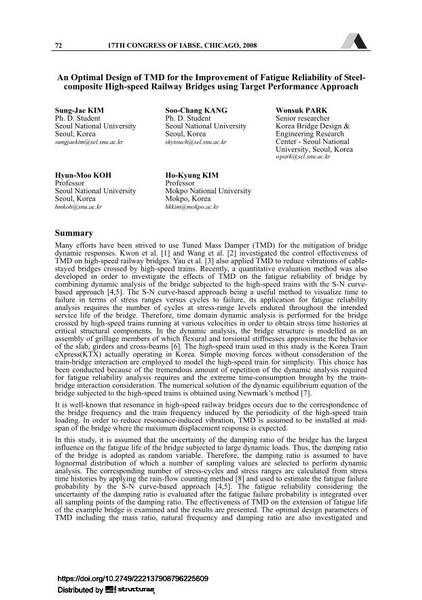An Optimal Design of TMD for the Improvement of Fatigue Reliability of Steel- composite High-speed Railway Bridges using Target Performance Approach

|
|
|||||||||||
Détails bibliographiques
| Auteur(s): |
Sung-Jae Kim
Soo-Chang Kang Wonsuk Park Hyun-Moo Koh |
||||
|---|---|---|---|---|---|
| Médium: | papier de conférence | ||||
| Langue(s): | anglais | ||||
| Conférence: | 17th IABSE Congress: Creating and Renewing Urban Structures – Tall Buildings, Bridges and Infrastructure, Chicago, USA, 17-19 September 2008 | ||||
| Publié dans: | IABSE Congress Chicago 2008 | ||||
|
|||||
| Page(s): | 72-73 | ||||
| Nombre total de pages (du PDF): | 7 | ||||
| Année: | 2008 | ||||
| DOI: | 10.2749/222137908796225609 | ||||
| Abstrait: |
This study investigates the effectiveness of Tuned Mass Damper (TMD) on the fatigue reliability of a steel-composite high-speed railway bridge. The extension of the fatigue life of the bridge brought by TMD designed to reduce resonance-induced vibration is verified. In parametric analyses, the extent of fatigue reliability improvement and the optimal design factors of TMD are studied by using the procedure of fatigue reliability evaluation based on dynamic analysis. Considering the uncertainties of the train velocities and the damping ratio of the high-speed railway bridge, a series of dynamic analyses is performed for the bridge subjected to moving loads. Stress time histories are determined from the time domain analysis at the critical structural components of the bridge. The rain-flow counting method is adopted to obtain a number of stress ranges and cycles from time history responses. Based on these stress ranges, cycles and intended service life, the fatigue failure probability is evaluated through the S-N curve-based approach. As a numerical example, a 40 m- span steel-composite bridge is considered. The effectiveness of TMD on the fatigue life of the bridge is examined and the results are presented. Moreover, the optimal design parameters of TMD including the mass ratio, natural frequency and damping ratio are investigated and determined. |
||||

